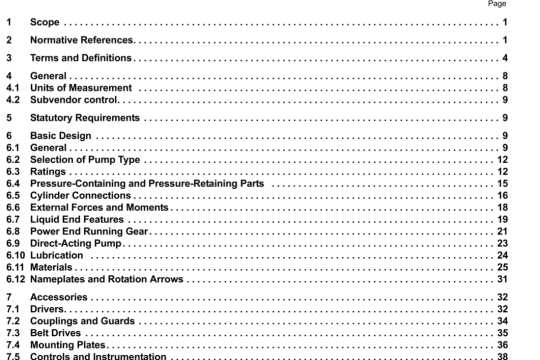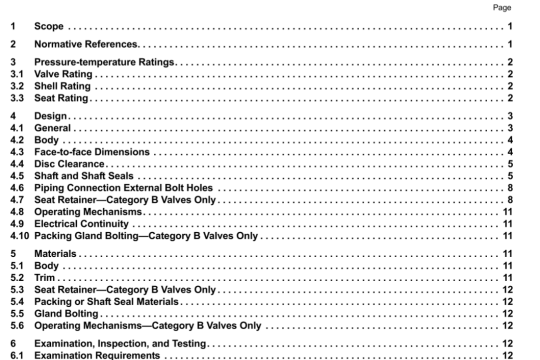API MPMS 3.1A:2005 pdf download
API MPMS 3.1A:2005 pdf download.Manual of Petroleum Measurement Standards Chapter 3-Tank Gauging
Section 1A—Standard Practice for the Manual auging of Petroleum and Petroleum Products.
b. Frequency of Verification
I. Portable electronic gauging tape assembly shall be
inspected daily or prior to each use to ensure that wear in the tape/sensor does not introduce error when the tape scale is being read, and the sensor is functional. Kinked or spliced tapes shall not be used in custody transfer
applications.
2. Portable electronic gauging devices shall be verified
when new and at least annually thereafter using the procedure in Appendix A. The sensorprobe shall be
checked using a beaker of water for detection signal at least once every six months.
3.IA.8.2 UNCERTAINTIES OF TANK
MEASUREMENTS
Gauge readings and tank capacity tables arc used to determine the total obscrvcd volume (TOV) of petroleum containcd in the tank. The accuracy of the TOV is limited by the inherent accuracy of the tank, rcgardlcss of thc gauging equipment used.
Note: While the scope of this standard is limited to the detennination of liquid level, a conversion oflcscl to volume will at some point he necessary. The following section is placed here to aid thc user in identifying possible inaccuracies associated with tank Incasurcn1ent
3.IA.8.2.1 Tank Capacity Table Accuracy
The API MPMS Chapter 2. Tank Calibration,” describes the methods and procedures used to calibrate a tank as well as the calculation procedures used to develop a set of tank capacity tables from the tank calibration daia
Tank capacity tables produced from these procedures include inherent inaccuracies due to:
a. strapping tape calibration.
b swapping tape thermal expansion,
c. tension of the strapping tape.
d. correction for shell expansion due to liquid head (static head),
e. measurement of shell plate thickness.
f. calculation of deadwood. and
g. other factors.
The errors due to these inaccuracies can result in either an over- or under-statement of quantity.
3IA.8.2.2 Shell Expansion Due to Liquid Head
As a tank is tilled, the tank shell will expand due to the weight of the tank’s contents (liquid head). The liquid head correction head may be applied in volume calculations: or. alternatively, the liquid head correction should be incorporated into the tank Capacity table. Calculation procedures used to correct the tank capacity table for shell expansion due to liquid head are tiund in API MPMS Chapter 2.
An angular deflection of the tank shell near the bottom of the tank is the result of the bottom of the tank counteracting the shell expansion caused by an increasing liquid head when the tank is filled. This angular deflection of the tank shell (barreling) may result in movement of the tank bottom and the cone roof. A correction for these two movements is not contained in the tank capacity table.
3.IA.8.2.3 Bottom Movement
Tank bottoms may deform into the supporting soil under the weight of the tank contents. This dcfwmation can be either permanent (settlement) or elastic (diaphragming). Generally as the tank is filled, the bottom section adjacent to the tank shell moves upward because of the angular deflection of the tank shell. Further from the shell, the tank bottom is stationary. The center of the tank bottom moves downward. The amount of movement depends on the soil’s compressive strength and on the shape of the tank bottom.
With elastic deformation (diaphragming). the tank bottom moves up or down in relation to the height of the liquid contained in the tank. Unless tank capacity tables have been adjusted for the ctThet of elastic diaphragming of the tank, or unless water bottoms are employed to negate this feature. elastic diaphragming of the tank bottom results in an understatement of quantity on every transfer.
3.IA.8.2.4 Still Pipe (Stilling Well, Gauge Well) Tanks
Tanks, particularly floating roof tanks, are frequently fitted with still pipes. The upper lip of the still pipe is a good location for the reference gauge point. The lower end of the still pipe serves as a good location from which to support the datum plate. However, a vertical movement of the still pipe will cause the attached reference gauge point and datum plate to move vertically. This movement causes liquid height ineasureinent errors. The following describes a properly installed still pipe.




